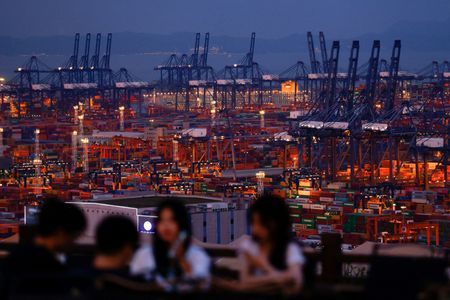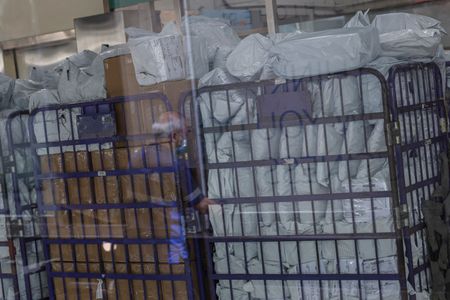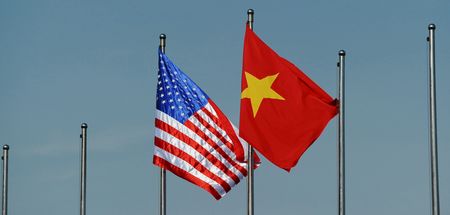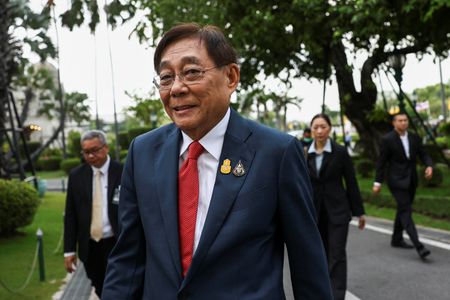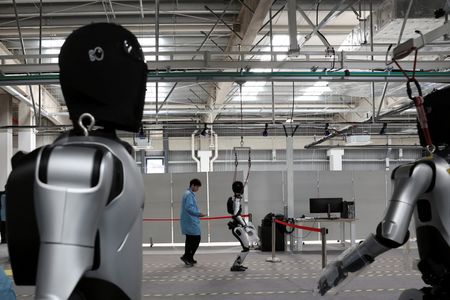By Jamie McGeever
ORLANDO, Florida (Reuters) – TRADING DAY
Making sense of the forces driving global markets
By Jamie McGeever, Markets Columnist
Movin’ on up
Relief and optimism coursed through world markets on Monday, putting a fire under stocks, the dollar and bond yields as U.S.-China tariff talks struck a surprisingly cooperative chord and raised hopes that the worst of the global trade crisis is over.
In my column today I look at the Fed’s more cautious, reactive approach to policymaking than many of its peers, who are cutting interest rates. More on that below, but first, a roundup of the main market moves.
I’d love to hear from you, so please reach out to me with comments at jamie.mcgeever@thomsonreuters.com. You can also follow me at @ReutersJamie and @reutersjamie.bsky.social.
Trading Day is also sent by email every weekday morning. Think your friend or colleague should know about us? Forward this newsletter to them. They can also sign up here.
If you have more time to read, here are a few articles I recommend to help you make sense of what happened in markets today.
1. U.S. and China reach deal to temporarily slash tariffs,easing slump fears 2. Investors cheer U.S.-China tariff truce, but cautiousover a final deal 3. What have China and the United States agreed to inGeneva? 4. Trump signs executive order to demand pharma industrycuts prices 5. Republicans leave many issues unresolved as they pushTrump tax bill forward
Today’s Key Market Moves
* Wall Street soars, with the Dow rising 2.8%, the S&P 500up 3.3% and the Nasdaq leaping 4.4%. The last two hit theirhighest since early March, all three close above their 200-daymoving averages. * Among the key global equity index gains: Hang Seng andHang Seng tech up 3% and 5%, respectively; India up nearly 4%;Japan and MSCI Asia ex-Japan up 2%. * U.S. Treasury yields shoot higher, by as much as 13 bps atthe short end. The 2-year yield climbs back above 4.00%. * Gold slides nearly 3%. * The dollar index leaps 1.4%, its best day since the U.S.election last November and one of its best in recent years.Dollar/yen soars 2%.
Tariff truce a market ‘game changer’
Whatever the longer-term outlook is for world trade, economic growth and financial markets, there’s little doubt that the near-term prospects are brighter today than they were at the end of last week.
The unexpectedly cordial and fruitful talks between the U.S. and China in Geneva at the weekend defused trade tensions between the world’s two largest economies and dramatically reduced the tail risks investors had priced into world markets.
Many economists on Monday raised their Chinese growth forecasts, even though the projected stimulus from Beijing will now probably be lower, and some upped their U.S. outlook too.
Of course, wherever U.S. import tariffs eventually settle, they will be much higher than they were before President Donald Trump came to power, probably still the highest in almost a century. But relative to expectations – as recently as Friday Trump was floating 80% tariffs on Chinese goods – the numbers announced and the 90-day pause are unambiguously positive for risk appetite.
The positivity is based on three broad factors – the level of tariffs agreed upon, the willingness of both countries to keep talking, and the signal it sends about Washington’s conciliatory approach to negotiations with other countries.
“The China tariff reprieve is a game-changer for tactical risk,” says Citi’s Stuart Kaiser. “There are clearly still large policy and economic risks, but we see no reason to stand in the way of systematic buying.”
Systematic buying was the name of the game on Monday. The S&P 500 and Nasdaq both smashed through their 200-day moving averages, closing above the closely-watched technical level for the first time since late March. That proved to be a false dawn – will this time be different?
A thaw in U.S.-Sino trade tensions is not the only reason for investors’ optimism on Monday – global geopolitical tensions appear to be cooling on multiple fronts too.
Ukrainian President Volodymyr Zelenskiy said he is willing to hold talks with Russian counterpart Vladimir Putin in Istanbul later this week, a meeting Trump on Monday said he would be willing to attend too.
The ceasefire between India and Pakistan agreed on Saturday appears to be holding, Hamas on Monday released a U.S. hostage, and the Kurdistan Workers Party (PKK) militant group, which has been locked in bloody conflict with the Turkish state for more than four decades, is disbanding and ending its armed struggle.
So, a ceasefire in the global trade war and signs of de-escalation in actual military conflicts. Reasons for investors to be relieved and even cheerful.
Fed tests limits of ‘wait and see’
A split is emerging between the Federal Reserve and other major central banks as they try to assess the economic impact of the rapidly shifting global trade war.
The Fed has kept interest rates on hold in the face of rising inflation risk, while many of its peers are cutting to cushion the blow from the looming growth slowdown.
The Fed’s cautious stance runs the risk of leaving Chair Jerome Powell and team behind the curve once again.
With its decision last week to leave rates unchanged, the gap between the Fed’s and European Central Bank’s respective policy rates is the widest in more than two years. U.S. interest rates have not been higher than Canada’s since 1997.
Powell said last week he and his colleagues could afford to maintain a patient policy stance because the U.S. economy was, on the face of it, still in good shape. Growth and the labor market are strong, and inflation is reasonably close to their 2% target.
The costs of waiting were “fairly low”, he told reporters after the Fed left policy unchanged. “We can move quickly when appropriate. But there’s so much uncertainty … I can’t really give you a time frame on that.”
The inference here is that any economic damage from delaying the resumption of its easing cycle – remember the Fed cut rates 100 basis points between August and December of last year – will be neutralized by more aggressive moves later.
That may be wishful thinking.
While Powell is correct that the “hard” economic data, like unemployment and retail sales, remains fairly healthy, “soft” data such as sentiment surveys right now are “about as dark as it gets,” according to Moody’s chief economist Mark Zandi. And confidence has a direct impact on consumer, business, and investor spending.
It’s tough to predict exactly how strong that link is right now, as it has weakened since the pandemic. But by the time the Fed detects serious deterioration in the “hard” data, underlying growth has probably already cooled meaningfully, meaning it may be too late to prevent a recession.
EXPORTING INFLATION
To be fair to Powell, the cautious U.S. stance is more reasonable when viewed through an inflation lens.
U.S. inflation expectations are significantly higher than those elsewhere as consumers brace for a steep rise in prices later this year due to incoming import tariffs. These expectations may shift following news on Monday of a significant de-escalation in U.S.-Sino trade tensions.
But even after trade agreements are reached, America’s average effective tariffs will still be the highest in decades. And more than 75% of companies surveyed by the Fed have stated they will be passing cost increases along to consumers.
And if the U.S.-China ceasefire doesn’t hold, Beijing would almost certainly redirect its shipments of cheap goods previously bound for the U.S. to the rest of the world. All else being equal, that would put upward pressure on inflation in the U.S. while exerting downward pressure in other developed economies. This may largely explain the Fed’s more cautious and reactive stance.
‘EXCESSIVE UNANIMITY’
“The Fed suffers from excessive unanimity disease,” says Willem Buiter, former rate-setter at the Bank of England. He argues that there is a tendency among central banks to be “excessively gradualist” when it comes to changing rates. If policymakers know their end goal, he says, they should try and get there as quickly as possible without sparking unwanted financial market volatility.
The trouble is the Fed doesn’t have an idea of what its end goal is because of the fog of uncertainty Trump’s trade war has created. Powell refused to definitely say which side of the Fed’s employment and inflation dual mandate he and his colleagues consider the bigger risk to the economy.
Even in the best of times, setting policy is an uncertain science and vulnerable to the vagaries of Milton Friedman’s “long and variable” lag.
“You never get it quite right – you’re either too fast or too slow,” says Steve Dean, Chief Investment Officer at Compound Planning.
Investors don’t seem to be too worried right now about the policy stasis, especially given the increasingly positive news on the trade war front in recent weeks. Wall Street has fully recovered the ground lost immediately after April 2.
And if the trade war fog clears up, the Fed will be in a better position to act, perhaps justifying Powell’s “wait and see” approach. But we may need to wait another 90 days to find out.
What could move markets tomorrow?
* UK employment (March) * BoE Governor Andrew Bailey, chief economist Huw Pill speakat separate events * Germany ZEW business sentiment (May) * U.S. CPI inflation (April)
Opinions expressed are those of the author. They do not reflect the views of Reuters News, which, under the Trust Principles, is committed to integrity, independence, and freedom from bias.
(By Jamie McGeever, editing by Nia Williams)

